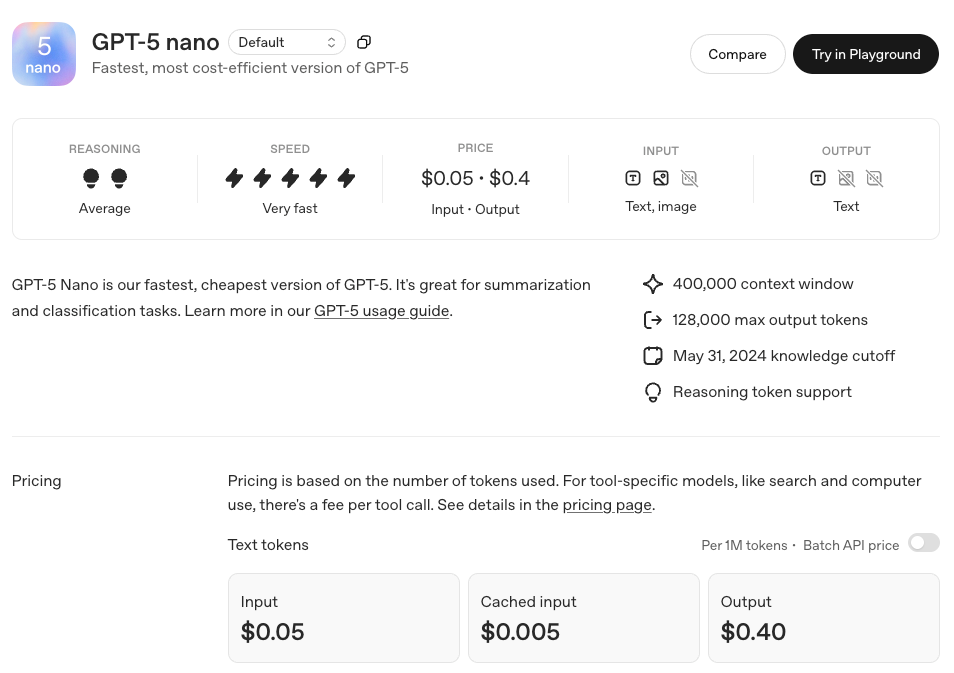AIBase Message, August 7, 2025, OpenAI officially released the GPT-5 series model, which is the most important product upgrade in the company's history. This release includes four versions: GPT-5, GPT-5Mini, GPT-5Nano, and GPT-5Pro, each deeply optimized for different application scenarios, marking a new development stage in AI technology.
Unified Intelligent System: Revolutionary Breakthrough in Technical Architecture
GPT-5 is positioned by OpenAI as a "Unified Intelligent System," successfully integrating capabilities that were previously scattered across different models: multi-modal processing from GPT-4o, deep reasoning from the o-series, advanced mathematical computation, and agent task execution. This architectural innovation allows users to avoid manually switching between different models; the system automatically selects the most suitable processing method based on task complexity through a real-time router.
In terms of core technical indicators, GPT-5 has achieved comprehensive breakthroughs:
- Mathematical Reasoning: Achieved 94.6% accuracy in the AIME2025 benchmark test without external tools
- Code Ability: Scored 74.9% in the SWE-bench Verified test, and 88% in the Aider Polyglot multi-language programming test
- Multi-modal Understanding: Scored 84.2% in the MMMU benchmark test
- Professional Knowledge: Scored 88.4% in the GPQA general question answering test
Detailed Analysis of the Four Versions

GPT-5 (Flagship Version): Strongest Reasoning and Multi-modal Capabilities
As the flagship product of the series, GPT-5 is designed for complex tasks, featuring the following core characteristics:
Reasoning Capability Breakthrough: It has built-in Chain-of-Thought technology, enabling it to break down complex problems and solve them step by step. In internal tests, GPT-5 outperformed all previous models on complex tasks in over 40 professional fields.
Comprehensive Multi-modal Support: Supports text, image, voice, and video processing, inheriting Sora's video generation technology. Users can upload various formats of content, and GPT-5 can generate corresponding responses or perform compound tasks, such as analyzing medical images or real-time translating video content.
Agent-like Task Execution: Supports automatic web browsing, generating complete software applications, managing schedules, and other complex operations. During the launch demonstration, GPT-5 generated a complete French learning Web application with flashcards, quizzes, and progress tracking within seconds based on a simple description.
Significantly Reduced Hallucination Rate: Through the "Safe Completion" technology, the factual error rate of GPT-5 is about 45% lower than that of GPT-4o, and the error rate is about 80% lower than that of the o3 model when using the reasoning mode.
GPT-5Mini: Cost-effective Lightweight Option

GPT-5Mini is optimized for cost-sensitive applications, significantly reducing resource requirements while retaining core functionalities:
- Supports medium-complexity chain-of-thought tasks
- Has text, image, and voice processing capabilities, with relatively limited video processing features
- Can run on low-power devices, suitable for small and medium-sized enterprises and individual developers
- Approaches the performance level of o4-mini in core reasoning tests
Main application scenarios include educational content generation, customer service automation, and handling simple multi-modal tasks.
GPT-5Nano: Ultra-efficient Edge Computing Model

GPT-5Nano is optimized for speed and low resource consumption, making it the lightest version in the series:
- Extremely low latency response, specifically designed for real-time applications
- Can run on devices with only 16GB of memory, including MacBook or low-end servers
- Its reasoning capability is simplified, mainly used for quick interactions and simple tasks
- Performs similarly to o3-mini in general benchmark tests
It is suitable for scenarios such as mobile device applications, embedded systems, real-time translation, and voice assistants where high response speed is required.
GPT-5Pro: Enhanced Version for Professional Users
GPT-5Pro is a high-performance version designed for premium users and enterprises:
Enhanced Reasoning Mode: Supports the "GPT-5Thinking" feature, enabling deeper and longer reasoning for complex issues, ensuring extremely high accuracy.
Unlimited Access: Pro users have unlimited access to GPT-5 and exclusive access to GPT-5Pro.
Professional Multi-modal Capabilities: Excels in video processing, complex image analysis, and other tasks, scoring 46.2% in the HealthBench Hard medical benchmark test.
Deep Tool Integration: Seamlessly integrates search, Canvas, code execution, and other professional tools, providing a complete workflow experience.
Pricing Strategy: The Largest Free Open Access in History
OpenAI adopted an unprecedented open strategy, providing access to GPT-5 for all user groups:
Free Users: Can use GPT-5 and GPT-5Mini, with usage limits; if exceeded, it will automatically switch to the Mini version
Plus Users ($20/month): Enjoy higher usage limits, suitable for individual users and small teams
Pro Users ($200/month): Have unlimited access to GPT-5 and GPT-5Pro, and can use the "GPT-5Thinking" mode
Enterprise and Education Users: Gain access within one week after the release and can use the GPT-5Pro version
API Pricing: $1.25 per million tokens for input, $10 per million tokens for output, targeting professional developers
Comprehensive User Experience Upgrades
The GPT-5 series brings multiple user experience innovations:
Smart Model Selection: The system automatically selects the most suitable model version based on task complexity and user intent, eliminating the need for manual switching
Personalized Interaction: Offers four preset personalities (Cynic, Robot, Listener, Nerd) and customizable chat color options
Enhanced Memory Capabilities: A larger context window can remember longer conversation histories, providing a more coherent interaction experience
User-friendly Design: Compared to GPT-4o, the new model reduces overly flattering expressions and uses fewer unnecessary emojis, making the interaction more natural
Technical Architecture Innovations
The GPT-5 series may have adopted a mixture of experts (MoE) architecture, significantly improving efficiency by reducing the number of active parameters. The training data primarily consists of English texts, focusing on STEM, programming, and general knowledge areas, with the knowledge cutoff date being June 2024. The entire training process was completed on NVIDIA H100 GPUs, consuming approximately 2.1 million GPU hours.
Competitive Advantages and Market Impact
In the current competitive AI environment, the release of GPT-5 holds significant strategic importance. Facing strong competitors such as Anthropic Claude3.5Sonnet, xAI Grok4, and Google Gemini2.5Pro, OpenAI strengthens its market position through its free open access strategy and significantly reduced hallucination rates.
According to statistics, there are currently 5 million paid users using ChatGPT commercial products, including well-known institutions such as BNY Mellon, California State University, Figma, Intercom, and Morgan Stanley. The release of GPT-5 is expected to further accelerate enterprise AI adoption and drive digital transformation across industries.
Industry Outlook and Challenges
The release of the GPT-5 series represents a new milestone in AI technology development but also faces some challenges:
Privacy and Security: Multi-modal capabilities involve handling sensitive data such as medical images and personal conversations, making data protection a key issue
Technical Impact: The increased level of automation may impact traditional jobs, requiring social-level adaptation and adjustment
Performance Verification: Although OpenAI claims that GPT-5 has "doctor-level intelligence," its actual reasoning capabilities in practical applications still need time to verify
Summary
The release of the GPT-5 series marks another major breakthrough for OpenAI in the field of AI. Through differentiated layouts of four versions, OpenAI has successfully covered the entire demand spectrum from individual users to enterprise customers. This is not just a technological upgrade but also a comprehensive innovation in AI product strategies.
As GPT-5 becomes the new default model in ChatGPT, replacing previous versions like GPT-4o and o3, users simply need to open ChatGPT and enter their questions; the system will automatically handle the tasks and apply reasoning functions when needed. The realization of this seamless experience indicates that AI technology is rapidly evolving from a tool to an assistant, and from a support role to a collaborative one.
